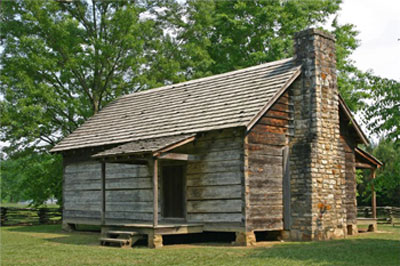The forced adaptation to a way of life similar to the white settlers resulted in major shifts in culture and livelihood. The destruction of the Cherokee home front during the Creek War proved one of the strongest indications that adherence to, and even success within, the government’s “civilization” policy would not matter.
The Cherokees endured these offenses in hopes of demonstrating their fidelity to the United States government. Cherokees believed that a violent response to the attacks on their home front would only result in greater destruction for their Nation.

Georgia State Parks
After the American Revolution, the new United States government created a “civilization” policy that it promoted among Indian groups. The goal of “civilization” was to force Cherokees and other Indians away from their traditional occupations of hunting and warfare into livelihoods that resembled those of white citizens and settlers, such as farming. “Civilization” constrained Cherokee men who once derived their status through hunting and gift-giving. The government’s desire to make Cherokee men farmers proved culturally problematic. The Cherokees did not need to learn how to farm, as the prime occupation of a Cherokee woman was indeed agriculture. To avoid a loss of manhood associated with doing women’s work, some Cherokees farmed with slaves on plantations. Others raised livestock on smaller farmsteads. Either way, Cherokees that embraced “civilization” resided in dwellings that resembled those of white settlers, and their occupants engaged in similar duties.
When Cherokee warriors went to participate in the Creek War, they left their homesteads and families vulnerable to intrusions by white squatters. The greatest source of destruction, however, came in the form of an East Tennessee militiamen returning home from the Creek War. These men demolished fencing, burned homes, stole slaves and horses, and destroyed livestock and other foodstuffs, such as corn. The militiamen did not bother to differentiate between their Indian allies and foes.
Women, children, and the elderly experienced threats and acts of violence. Catherine Brown, daughter of a warrior fighting with Jackson, fled her home and hid in the woods to escape the possibility of rape at the hands of the militiamen. The Cherokees endured these offenses in hopes of demonstrating their fidelity to the United States government. Cherokees believed that a violent response to the attacks on their home front would only result in greater destruction for their Nation.
Yet, this did not come to pass, as the federal government refused to compensate the tribe for the tens of thousands of dollars of damage inflicted by marauding militiamen. When Indian agent Return J. Meigs complained, Jackson defended his soldiers’ actions arguing that testimonies provided by Indians were untrustworthy.
The destruction of the Cherokee home front during the Creek War proved one of the strongest indications that adherence to, and even success within, the government’s “civilization” policy would not matter. Cherokee men farmed with and without slaves, raised livestock, and engaged in other commercial endeavors. Cherokee women learned to spin. In both cases, the Cherokee embrace of “civilization” proved of little importance in the face of continued and mounting pressure for land by white, western settlers.
Last updated: August 14, 2017
